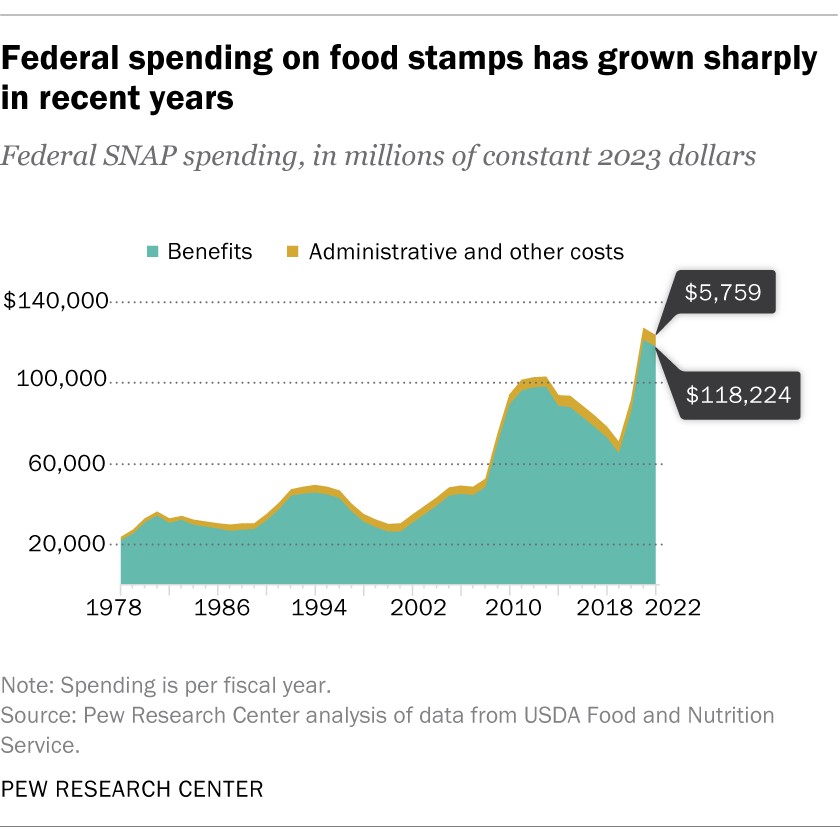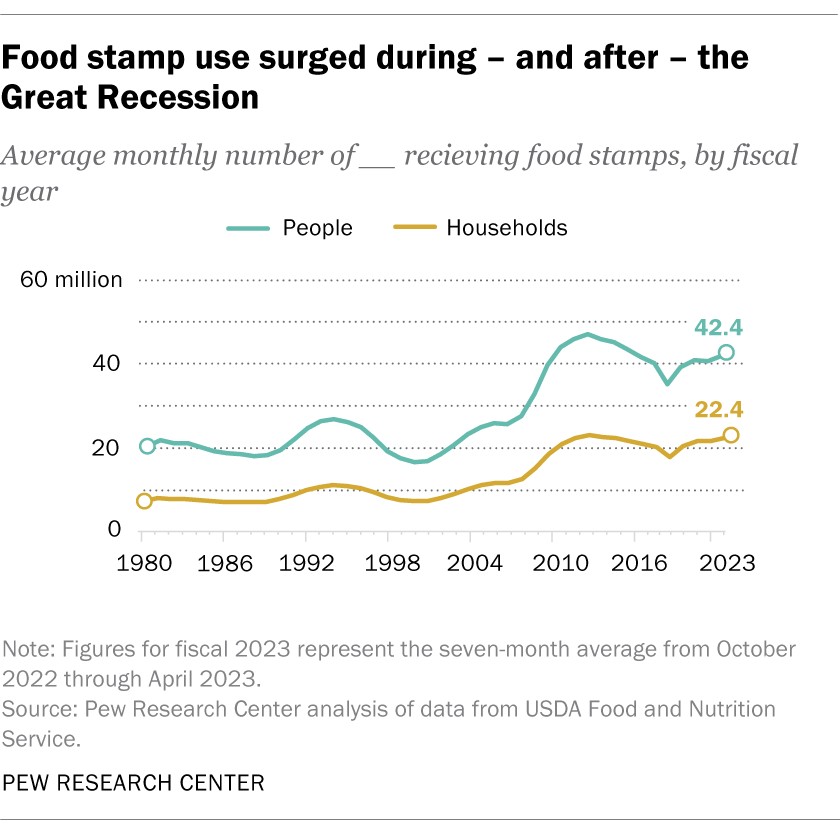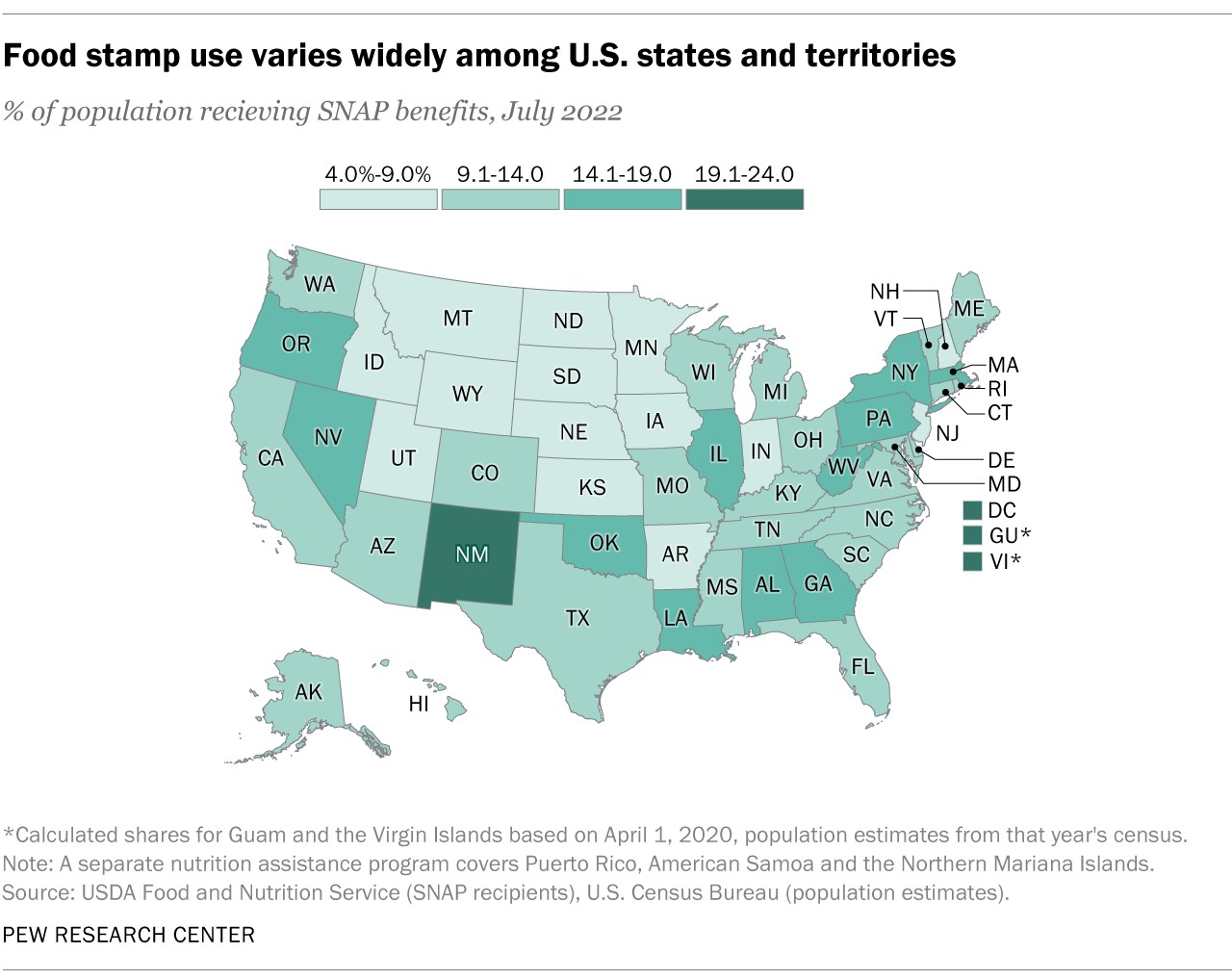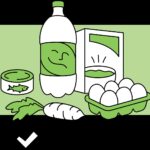Do Taxpayers Pay For Food Stamps? The Supplemental Nutrition Assistance Program (SNAP), often referred to as food stamps, is a critical component of the US social safety net, providing essential food assistance to millions of Americans. It’s natural to wonder how this program is funded and what impact it has on taxpayers like you and me. At FOODS.EDU.VN, we are committed to providing clarity and comprehensive knowledge regarding various aspects of nutrition, including how food assistance programs work. Dig deeper into the intricacies of SNAP funding, how it benefits recipients and the economy, and debunk common myths surrounding the program, exploring the federal food assistance, nutritional support and economic impact.
1. SNAP: An Overview of the Food Stamp Program
The Supplemental Nutrition Assistance Program (SNAP), formerly known as food stamps, is a federal program that provides food assistance to low-income individuals and families. Administered by the U.S. Department of Agriculture (USDA), SNAP aims to combat food insecurity and improve the nutritional health of participants.
1.1. Objectives and Goals of SNAP
- Combating Food Insecurity: SNAP is designed to ensure that low-income individuals and families have access to nutritious food, reducing hunger and food insecurity.
- Improving Nutritional Health: By providing benefits specifically for food purchases, SNAP promotes healthier eating habits and better nutritional outcomes.
- Supporting Economic Stability: SNAP benefits can free up household income, allowing families to meet other essential needs such as housing and healthcare.
1.2. Eligibility Criteria for SNAP Benefits
To be eligible for SNAP benefits, households must meet certain income and resource requirements. These criteria typically include:
- Income Limits: Gross monthly income must be at or below 130% of the federal poverty level, and net monthly income (after deductions) must be at or below 100% of the poverty level.
- Resource Limits: Households are limited in how much they can have in cash, investments, and other assets.
- Work Requirements: Able-bodied adults without dependents (ABAWDs) must meet work requirements, such as working or participating in a work program for a certain number of hours per week.
- Residency and Citizenship: Applicants must be U.S. citizens or qualified non-citizens and reside in the state where they are applying.
2. Funding Sources for SNAP: Where Does the Money Come From?
SNAP is primarily funded through federal tax dollars, with some state contributions for administrative costs. Understanding the funding sources helps clarify the role of taxpayers in supporting this vital program.
2.1. Federal Funding
The majority of SNAP funding comes from the federal government, allocated through the USDA’s budget. This funding covers the cost of food benefits distributed to eligible households, as well as administrative expenses.
- Mandatory Spending: SNAP is considered a mandatory spending program, meaning that funding is automatically allocated each year based on eligibility and participation rates. This ensures that SNAP can respond effectively to changing economic conditions and levels of need.
- Annual Appropriations: While SNAP is primarily funded through mandatory spending, Congress can make adjustments to the program through annual appropriations bills. These adjustments may affect eligibility criteria, benefit levels, and administrative funding.
2.2. State Contributions
While the federal government covers the majority of SNAP costs, states also contribute to the program, primarily for administrative expenses.
- Administrative Costs: States are responsible for a portion of the administrative costs associated with running the SNAP program, such as processing applications, conducting eligibility determinations, and providing outreach and education.
- Supplemental Programs: Some states may also supplement federal SNAP benefits with state-funded programs, providing additional assistance to low-income residents.
2.3. Allocation of Funds: How SNAP Dollars Are Spent
Understanding how SNAP funds are allocated provides insight into the program’s impact on both recipients and the broader economy.
- Food Benefits: The largest portion of SNAP funding goes directly to providing food benefits to eligible households. These benefits are distributed through Electronic Benefit Transfer (EBT) cards, which can be used to purchase eligible food items at authorized retailers.
- Administrative Costs: A smaller portion of SNAP funding is used to cover administrative costs, such as salaries for program staff, technology infrastructure, and outreach efforts.
- Nutrition Education: SNAP also funds nutrition education programs, which aim to promote healthy eating habits and improve food choices among participants. These programs may include cooking classes, nutrition counseling, and educational materials.
3. The Role of Taxpayers in Supporting SNAP
As a federally funded program, SNAP relies on taxpayer dollars to operate. Understanding the role of taxpayers in supporting SNAP can help foster informed discussions about the program’s value and impact.
3.1. Taxpayer Contributions to SNAP Funding
SNAP is funded through a variety of federal taxes, including income taxes, payroll taxes, and excise taxes. These taxes collectively contribute to the overall federal budget, from which SNAP funding is allocated.
- Progressive Taxation: The U.S. tax system is progressive, meaning that higher-income individuals and corporations pay a larger percentage of their income in taxes. This helps ensure that those who are most able to contribute to public programs like SNAP do so.
- Budget Priorities: SNAP is just one of many programs funded through the federal budget. Decisions about how much funding to allocate to SNAP reflect broader policy priorities and trade-offs.
3.2. Economic Impact of SNAP: Benefits for Taxpayers
While SNAP relies on taxpayer funding, it also provides several economic benefits that can ultimately benefit taxpayers.
- Stimulating the Economy: SNAP benefits help stimulate the economy by increasing demand for food and supporting local businesses. When SNAP recipients spend their benefits at grocery stores and farmers markets, it generates revenue for these businesses and supports jobs in the food industry.
- Reducing Healthcare Costs: By improving food security and promoting healthier eating habits, SNAP can help reduce healthcare costs associated with malnutrition and diet-related diseases. This can lead to savings for taxpayers through lower Medicaid and Medicare expenditures.
- Increasing Productivity: SNAP can help improve the productivity of low-income individuals by ensuring they have access to nutritious food. This can lead to better educational outcomes, increased workforce participation, and higher earnings over time.
3.3. Accountability and Oversight: Ensuring Responsible Use of Taxpayer Funds
To ensure that SNAP is operating efficiently and effectively, there are several mechanisms in place for accountability and oversight.
- Program Audits: The USDA conducts regular audits of SNAP to ensure that funds are being used appropriately and that program requirements are being met. These audits help identify areas for improvement and prevent fraud and abuse.
- Performance Measurement: SNAP uses performance metrics to track key outcomes, such as participation rates, benefit accuracy, and program efficiency. These metrics provide valuable information for program managers and policymakers.
- Stakeholder Engagement: SNAP engages with a wide range of stakeholders, including recipients, advocacy groups, and community organizations, to gather feedback and improve program design and implementation.
4. Common Misconceptions About SNAP and Taxpayer Burden
Addressing common misconceptions about SNAP is crucial for promoting a more informed understanding of the program and its impact on taxpayers. Many myths exaggerate the financial burden and misrepresent the program’s beneficiaries.
4.1. Myth: SNAP Recipients Are Lazy and Unwilling to Work
One of the most pervasive misconceptions about SNAP is that recipients are lazy and prefer to rely on government assistance rather than seek employment.
- Reality: The majority of SNAP recipients are children, elderly, or disabled individuals who are unable to work. Among able-bodied adults, many are employed in low-wage jobs and rely on SNAP to supplement their income. Additionally, SNAP has work requirements for able-bodied adults without dependents, requiring them to work or participate in a work program to maintain eligibility.
- Supporting Evidence: According to USDA data, a significant percentage of SNAP households have earnings, and many recipients work multiple jobs to make ends meet. The program also provides resources and support for recipients seeking employment, such as job training and placement services.
4.2. Myth: SNAP Benefits Are Used to Purchase Non-Essential Items
Another common misconception is that SNAP benefits are used to purchase non-essential items such as alcohol, tobacco, or luxury goods.
- Reality: SNAP benefits can only be used to purchase eligible food items, such as fruits, vegetables, meat, dairy products, and bread. The program strictly prohibits the purchase of non-food items, alcohol, tobacco, and other ineligible products.
- Supporting Evidence: SNAP retailers are closely monitored to ensure compliance with program rules, and violations can result in penalties such as disqualification from the program. Additionally, SNAP Electronic Benefit Transfer (EBT) cards are designed to prevent the purchase of ineligible items, automatically rejecting transactions for prohibited products.
4.3. Myth: SNAP Fraud Is Widespread and Rampant
Some critics argue that SNAP is plagued by widespread fraud and abuse, resulting in significant losses for taxpayers.
- Reality: While fraud does occur in SNAP, it is relatively rare, and the program has robust safeguards in place to prevent and detect fraudulent activity. The USDA and state agencies work together to monitor SNAP transactions, investigate suspicious activity, and prosecute individuals who attempt to defraud the program.
- Supporting Evidence: According to USDA data, SNAP fraud rates are quite low, with the vast majority of benefits being used appropriately by eligible recipients. The program also utilizes advanced technology and data analytics to identify potential fraud schemes and prevent improper payments.
5. Exploring the Benefits of SNAP for Recipients and Communities
SNAP provides numerous benefits for recipients and communities, extending beyond basic food assistance. Understanding these advantages can foster a greater appreciation for the program’s role in promoting well-being and economic stability.
5.1. Improving Food Security and Health Outcomes
One of the primary benefits of SNAP is its ability to improve food security and health outcomes for low-income individuals and families.
- Reducing Hunger: SNAP helps reduce hunger by providing recipients with resources to purchase nutritious food, ensuring they have access to adequate meals.
- Improving Dietary Intake: SNAP encourages healthier eating habits by allowing recipients to purchase a variety of foods, including fruits, vegetables, and lean proteins, leading to improved dietary intake and nutritional status.
- Preventing Chronic Diseases: By promoting healthier eating habits, SNAP can help prevent chronic diseases such as obesity, diabetes, and heart disease, reducing healthcare costs and improving overall well-being.
5.2. Supporting Economic Stability and Self-Sufficiency
In addition to improving food security, SNAP supports economic stability and self-sufficiency for low-income individuals and families.
- Freeing Up Resources: SNAP benefits free up household income, allowing families to meet other essential needs such as housing, healthcare, and transportation.
- Promoting Work Participation: SNAP has work requirements for able-bodied adults, encouraging them to seek employment and become self-sufficient. The program also provides resources and support for recipients seeking employment, such as job training and placement services.
- Boosting Local Economies: SNAP benefits stimulate local economies by increasing demand for food and supporting local businesses such as grocery stores and farmers markets.
5.3. Strengthening Communities and Reducing Poverty
SNAP plays a vital role in strengthening communities and reducing poverty by providing a safety net for vulnerable populations.
- Reducing Poverty Rates: SNAP helps reduce poverty rates by providing low-income individuals and families with resources to meet their basic needs, lifting them out of poverty.
- Supporting Vulnerable Populations: SNAP provides a safety net for vulnerable populations such as children, the elderly, and the disabled, ensuring they have access to nutritious food and essential resources.
- Building Stronger Communities: By reducing hunger and poverty, SNAP helps build stronger communities and create a more equitable society.
6. Recent Changes and Updates to SNAP
Keeping up with recent changes and updates to SNAP is essential for understanding the program’s current status and future direction. These changes often reflect evolving economic conditions, policy priorities, and program evaluations.
6.1. Impact of the COVID-19 Pandemic on SNAP
The COVID-19 pandemic had a significant impact on SNAP, leading to increased enrollment and expanded benefits to address rising food insecurity.
- Increased Enrollment: As unemployment rates soared during the pandemic, SNAP enrollment increased dramatically, with millions of Americans turning to the program for assistance.
- Expanded Benefits: Congress authorized temporary increases in SNAP benefits to help households cope with the economic fallout of the pandemic, providing additional resources to purchase food.
- Flexibility and Waivers: The USDA granted states flexibility and waivers to streamline SNAP operations and make it easier for eligible households to access benefits during the pandemic.
6.2. Changes to Work Requirements and Eligibility Criteria
Recent legislation and policy changes have affected SNAP work requirements and eligibility criteria, impacting who can receive benefits and under what conditions.
- Work Requirement Changes: Some states have implemented stricter work requirements for SNAP recipients, requiring them to work or participate in a work program for a certain number of hours per week to maintain eligibility.
- Eligibility Restrictions: Policy changes have also targeted certain populations, such as able-bodied adults without dependents, restricting their access to SNAP benefits or imposing stricter eligibility requirements.
- Impact on Recipients: These changes have raised concerns about their potential impact on vulnerable populations, particularly those facing barriers to employment or lacking access to resources and support.
6.3. Innovations in SNAP Technology and Service Delivery
To improve program efficiency and enhance service delivery, SNAP has embraced technological innovations such as online application portals, mobile apps, and data analytics.
- Online Application Portals: Many states now offer online application portals for SNAP, making it easier for eligible households to apply for benefits from the comfort of their homes.
- Mobile Apps: Mobile apps allow SNAP recipients to check their benefit balances, locate authorized retailers, and access nutrition education resources on their smartphones.
- Data Analytics: Data analytics tools help SNAP agencies identify potential fraud schemes, detect errors, and improve program performance.
7. How SNAP Compares to Other Federal Assistance Programs
Comparing SNAP to other federal assistance programs provides a broader perspective on the role of social safety nets in supporting vulnerable populations. SNAP operates alongside programs like TANF, SSI, and WIC, each designed to address specific needs.
7.1. SNAP vs. Temporary Assistance for Needy Families (TANF)
TANF provides cash assistance to low-income families with children, while SNAP provides food assistance. Both programs serve similar populations but address different needs.
| Feature | SNAP | TANF |
|---|---|---|
| Primary Purpose | Food assistance | Cash assistance to families with children |
| Eligibility | Income and resource limits | Income limits, work requirements, family status |
| Benefits | Electronic Benefit Transfer (EBT) | Cash payments |
| Funding Source | Federal | Federal block grants to states |
| Work Requirements | Yes, for ABAWDs | Yes, varies by state |



7.2. SNAP vs. Supplemental Security Income (SSI)
SSI provides cash assistance to low-income individuals who are elderly, blind, or disabled. SNAP can supplement SSI benefits by providing additional resources for food purchases.
| Feature | SNAP | SSI |
|---|---|---|
| Primary Purpose | Food assistance | Cash assistance to elderly, blind, or disabled |
| Eligibility | Income and resource limits | Age or disability, income and resource limits |
| Benefits | Electronic Benefit Transfer (EBT) | Cash payments |
| Funding Source | Federal | Federal |
| Work Requirements | Yes, for ABAWDs | Limited, encourages employment when possible |
7.3. SNAP vs. Special Supplemental Nutrition Program for Women, Infants, and Children (WIC)
WIC provides nutrition assistance to low-income pregnant women, infants, and children up to age five. SNAP can complement WIC benefits by providing additional food assistance to eligible families.
| Feature | SNAP | WIC |
|---|---|---|
| Primary Purpose | Food assistance | Nutrition assistance for women, infants, and children |
| Eligibility | Income and resource limits | Income limits, pregnancy or young child status |
| Benefits | Electronic Benefit Transfer (EBT) | Vouchers for specific food items |
| Funding Source | Federal | Federal grants to states |
| Work Requirements | Yes, for ABAWDs | No |
8. Success Stories: Real-Life Impact of SNAP
Highlighting success stories illustrates the positive impact of SNAP on individuals, families, and communities. These stories provide concrete examples of how SNAP helps people overcome challenges and improve their lives.
8.1. From Food Insecurity to Self-Sufficiency
Share a story of an individual or family who used SNAP benefits to overcome food insecurity and achieve self-sufficiency. This could involve obtaining employment, completing education or job training, or starting a small business.
- Example: Maria, a single mother of two, relied on SNAP benefits to feed her children while she attended community college. With the help of SNAP, she was able to focus on her studies and earn a degree in nursing. After graduation, she secured a job as a registered nurse and no longer needed SNAP benefits.
8.2. Improving Health Outcomes Through SNAP
Highlight a story of an individual who used SNAP benefits to improve their health outcomes. This could involve managing a chronic disease, improving dietary habits, or accessing healthcare services.
- Example: John, a senior citizen with diabetes, used SNAP benefits to purchase fresh fruits, vegetables, and whole grains, helping him manage his blood sugar levels and improve his overall health. With the support of SNAP, he was able to stay active, maintain his independence, and avoid costly hospitalizations.
8.3. Strengthening Communities with SNAP
Share a story of how SNAP has strengthened a local community by reducing hunger, supporting local businesses, and promoting economic development.
- Example: A rural town struggling with high rates of food insecurity and poverty saw a significant turnaround after implementing SNAP outreach programs. SNAP benefits helped boost sales at local grocery stores and farmers markets, creating jobs and stimulating the local economy. Additionally, SNAP-funded nutrition education programs helped residents adopt healthier eating habits and improve their overall well-being.
9. The Future of SNAP: Challenges and Opportunities
Looking ahead, SNAP faces various challenges and opportunities that will shape its future direction. Addressing these issues requires thoughtful policy solutions and innovative approaches.
9.1. Addressing Food Insecurity in a Changing Economy
As the economy evolves, SNAP must adapt to address emerging challenges such as automation, income inequality, and climate change, which can exacerbate food insecurity.
- Policy Recommendations: Consider policy recommendations such as increasing SNAP benefit levels, expanding eligibility criteria, and strengthening work supports to ensure that SNAP can effectively address food insecurity in a changing economy.
9.2. Promoting Healthy Eating and Preventing Chronic Diseases
With rising rates of obesity and diet-related diseases, SNAP has an opportunity to promote healthy eating habits and prevent chronic diseases among recipients.
- Program Innovations: Explore program innovations such as incentivizing the purchase of healthy foods, providing nutrition education and cooking classes, and partnering with healthcare providers to integrate nutrition services into SNAP.
9.3. Leveraging Technology to Improve Program Efficiency
Technology can play a key role in improving SNAP program efficiency, reducing administrative costs, and enhancing service delivery.
- Technological Solutions: Consider technological solutions such as online application portals, mobile apps, and data analytics to streamline SNAP operations and make it easier for eligible households to access benefits.
10. Conclusion: The Ongoing Importance of SNAP
The Supplemental Nutrition Assistance Program (SNAP) remains a vital component of the US social safety net, providing essential food assistance to millions of Americans. Taxpayer funding supports this program, which in turn yields significant economic and social benefits. By understanding the funding mechanisms, dispelling common misconceptions, and recognizing the positive impacts of SNAP, we can foster a more informed and compassionate approach to addressing food insecurity in our communities.
Explore More at FOODS.EDU.VN
Interested in learning more about SNAP, nutrition, and healthy eating? Visit FOODS.EDU.VN for a wealth of resources, including:
- Detailed guides on SNAP eligibility and benefits
- Healthy recipes for SNAP recipients
- Articles on nutrition and food security
- Expert advice from culinary professionals
For further inquiries, contact us at:
- Address: 1946 Campus Dr, Hyde Park, NY 12538, United States
- WhatsApp: +1 845-452-9600
- Website: FOODS.EDU.VN
FAQ: Understanding SNAP and Taxpayer Contributions
Here are some frequently asked questions about SNAP and how it’s funded by taxpayers:
-
What is SNAP, and who is eligible for it?
- SNAP, or the Supplemental Nutrition Assistance Program, provides food assistance to low-income individuals and families. Eligibility is based on income, household size, and other criteria.
-
How is SNAP funded?
- SNAP is primarily funded by the federal government through taxpayer dollars. States also contribute to administrative costs.
-
Do SNAP recipients have to meet work requirements?
- Yes, able-bodied adults without dependents (ABAWDs) must meet work requirements, such as working or participating in a work program, to maintain eligibility.
-
Can SNAP benefits be used to purchase anything?
- No, SNAP benefits can only be used to purchase eligible food items, such as fruits, vegetables, meat, and dairy products. Non-food items, alcohol, and tobacco are prohibited.
-
Is there a lot of fraud in the SNAP program?
- While fraud does occur, it is relatively rare, and SNAP has robust safeguards in place to prevent and detect fraudulent activity.
-
What are the economic benefits of SNAP?
- SNAP stimulates the economy by increasing demand for food, reducing healthcare costs, and improving productivity among low-income individuals.
-
How did the COVID-19 pandemic affect SNAP?
- The pandemic led to increased SNAP enrollment and expanded benefits to address rising food insecurity.
-
How does SNAP compare to other federal assistance programs like TANF and WIC?
- SNAP, TANF, and WIC serve different purposes but all provide assistance to low-income individuals and families. SNAP focuses on food assistance, TANF provides cash assistance, and WIC supports nutrition for women, infants, and children.
-
What are some of the challenges and opportunities facing SNAP in the future?
- Challenges include addressing food insecurity in a changing economy and promoting healthy eating. Opportunities include leveraging technology to improve program efficiency.
-
Where can I find more information about SNAP and related topics?
- Visit foods.edu.vn for detailed guides, recipes, articles, and expert advice on SNAP, nutrition, and healthy eating.
